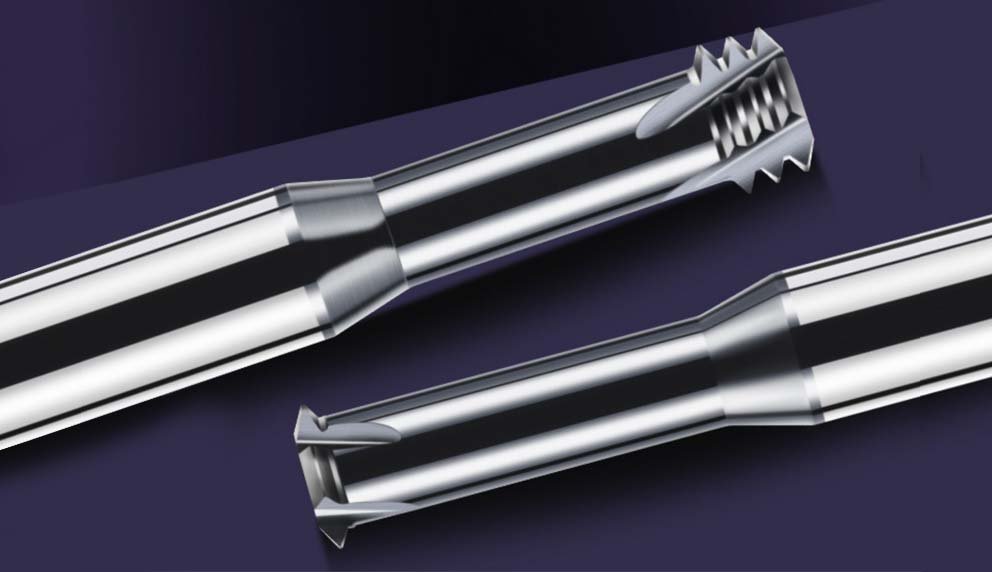
High-Speed Thread Milling: CNC Advancements for Large-Diameter and Deep Threads
Introduction
In the fast-evolving world of manufacturing, thread milling has emerged as a game-changer for producing large-diameter and deep threads with unmatched precision and efficiency. Powered by cutting-edge CNC (Computer Numerical Control) technology, thread milling offers a flexible, high-speed solution for industries like aerospace, energy, and heavy machinery. Whether you’re crafting massive threads for wind turbine towers or intricate deep threads for medical implants, the synergy of thread mills and CNC systems is revolutionizing how manufacturers tackle complex threading challenges. This article dives into the latest advancements in CNC thread milling, exploring how they deliver speed, precision, and sustainability, all while keeping things accessible for both seasoned engineers and curious newcomers.
The Evolution of Thread Milling: Why CNC is a Perfect Match
Thread milling, unlike traditional tapping, uses a thread mill—a specialized cutting tool that follows a helical path to create threads. This method shines when machining large-diameter threads (e.g., M50 or larger) or deep threads (depths exceeding three times the diameter). CNC machines, with their precise control over multi-axis movements, make thread milling faster and more reliable than ever. Modern CNC systems, equipped with high-speed spindles and advanced CAM software like Fusion 360 or Mastercam, generate optimized G-code to guide thread mills with pinpoint accuracy.
The evolution of thread milling is tied to CNC advancements. In the past, thread milling was slower and less precise, limited by manual or basic CNC controls. Today, multi-axis CNC machines (think five- or six-axis) enable complex toolpaths, slashing cycle times for large threads by up to 75%, according to industry studies. This speed boost is critical for industries where time is money, and precision is non-negotiable.
Table 1: Evolution of Thread Milling Technologies
| Era | Technology | Thread Mill Features | Cycle Time (M60 Thread) | Applications |
| 1990s | 3-Axis CNC, Basic G-Code | Single-tooth thread mills, HSS materials | ~15 minutes | General machining, small threads |
| 2000s | 4-Axis CNC, Early CAM Software | Multi-tooth thread mills, carbide materials | ~10 minutes | Automotive, medium threads |
| 2025 (Current) | 5/6-Axis CNC, AI-Optimized CAM | CBN/PCD-coated multi-tooth thread mills | ~3.5 minutes | Aerospace, energy, large/deep threads |
Data Source: Compiled from industry reports and CNC machining studies, 2024-2025.
This table highlights how thread milling has progressed, with modern thread mills leveraging advanced materials and CNC capabilities to achieve dramatic time savings, especially for large-diameter threads.
AI and IoT: Smarter Thread Milling for Real-Time Precision
The integration of artificial intelligence (AI) and the Internet of Things (IoT) is transforming thread milling into a smarter, more efficient process. AI-driven CNC systems analyze real-time data—such as cutting forces, tool wear, and spindle vibrations—to dynamically adjust thread milling parameters. For example, when machining a deep thread in titanium, AI can tweak the feed rate or spindle speed to prevent overheating, ensuring flawless thread geometry.
IoT takes this a step further by connecting CNC machines to cloud-based platforms. Sensors embedded in the spindle or thread mill monitor conditions like temperature and vibration, sending alerts if anomalies occur. This is a game-changer for large-diameter threads, where even a slight deviation can ruin a costly workpiece. A 2024 study by the Manufacturing Technology Institute found that IoT-enabled CNC systems reduced scrap rates by 30% in thread milling operations for energy sector components.
Next-Gen Thread Mills: Durability Meets Precision
The heart of thread milling lies in the thread mill itself. Recent innovations in tool materials and coatings have made these tools tougher and more versatile. Cubic boron nitride (CBN) and polycrystalline diamond (PCD) coatings allow thread mills to tackle high-hardness materials like nickel-based superalloys, common in aerospace turbine components. Nano-composite coatings, such as TiAlN or AlCrN, reduce friction and extend tool life by up to 50%, according to tool manufacturer Sandvik Coromant.
Multi-tooth thread mills are another leap forward. Unlike single-tooth designs, these tools cut multiple thread pitches in a single pass, slashing cycle times for large-diameter threads. For instance, a multi-tooth thread mill can machine an M100 thread in a wind turbine hub in under four minutes, compared to over ten minutes with older tools.
Table 2: Thread Mill Material Advancements
| Material/Coating | Hardness (HV) | Max Cutting Speed (m/min) | Tool Life (Threads Cut) | Best Use Case |
| High-Speed Steel (HSS) | 600-800 | 20-40 | ~500 | Soft metals, small threads |
| Carbide | 1500-1800 | 50-100 | ~2000 | General-purpose, medium threads |
| CBN-Coated | 3000-4000 | 100-150 | ~5000 | Superalloys, large/deep threads |
| PCD-Coated | 6000-8000 | 120-200 | ~7000 | Composites, high-precision threads |
Data Source: Tool manufacturer specifications and machining studies, 2024.
This table underscores how advanced thread mills enhance durability and speed, making them ideal for demanding applications like deep-thread machining.
Multi-Axis CNC: Conquering Complex Deep Threads
For deep threads—those with depths exceeding three times the diameter—multi-axis CNC machines are a revelation. Five- and six-axis CNC systems enable thread mills to follow intricate helical paths, ensuring uniform thread profiles even in challenging materials like titanium or Inconel. Six-axis machines, with their additional rotational freedom, can reduce machining time for deep threads by up to 75%, as noted in a 2025 CNC World report.
Consider a turbine shaft in aerospace, requiring a 100mm-deep M60 thread. A six-axis CNC machine, paired with a multi-tooth thread mill, can complete this task in a single setup, minimizing errors and ensuring thread consistency. This capability is critical for industries where precision directly impacts safety and performance.
Sustainable Thread Milling: Efficiency with a Green Edge
Sustainability is no longer a buzzword—it’s a priority. Thread milling excels here, as it generates less waste than traditional tapping. Optimized toolpaths, generated by CAM software, minimize material removal and reduce cutting fluid usage by up to 40%, per a 2024 sustainability study by the International Journal of Manufacturing. CNC machines with energy-efficient motors further lower the carbon footprint of large-diameter thread milling.
For example, in wind energy, machining massive threads for tower bases requires significant energy. Modern CNC systems, paired with eco-friendly thread mills, use high-pressure coolant systems to reduce heat and waste, aligning with green manufacturing goals. This makes thread milling a win-win for both performance and the planet.
Thread Milling in High-Stakes Industries
Industries like aerospace and energy rely on thread milling for critical components. In aerospace, large-diameter threads (e.g., M80) are used in turbine hubs, demanding tolerances below 0.01mm. Thread milling’s ability to handle superalloys ensures these threads meet stringent safety standards. In the energy sector, wind turbine towers and oil/gas pipelines use massive threads (M100+) to withstand extreme loads. A 2025 industry analysis by Global Energy Review noted that CNC thread milling reduced production times for wind turbine components by 20%, boosting project timelines.
Table 3: Thread Milling Applications by Industry
| Industry | Thread Type | Typical Size | Material | CNC Advantage | Cycle Time Savings |
| Aerospace | Deep, high-precision | M50-M80 | Titanium, Inconel | Multi-axis precision, minimal tool wear | 30-50% |
| Energy (Wind) | Large-diameter | M100+ | High-strength steel | High-speed multi-tooth thread mills | 20-40% |
| Oil & Gas | Deep, corrosion-resistant | M60-M120 | Stainless steel, alloys | High-pressure coolant, stable toolpaths | 25-45% |
| Heavy Machinery | Custom, large-diameter | M80-M150 | Carbon steel, alloys | Flexible CAM programming, rapid setup | 15-35% |
Data Source: Industry case studies and manufacturing reports, 2024-2025.
This table illustrates how thread milling meets diverse industry needs, delivering speed and precision for large and deep threads.
Rapid Customization: Thread Milling’s Flexibility
One of thread milling’s standout features is its adaptability. Unlike tapping, which requires specific tools for each thread size, a single thread mill can produce multiple thread profiles by adjusting CNC programs. This is a boon for industries needing custom threads, such as bespoke hydraulic cylinders in heavy machinery. CAM software enables rapid G-code generation, allowing manufacturers to switch from an M60 to an M100 thread in minutes. This flexibility supports small-batch production and rapid prototyping, cutting lead times by up to 30%, per a 2024 Manufacturing Today study.
Training for the Future: VR and AR in Thread Milling
As the demand for skilled CNC operators grows, virtual reality (VR) and augmented reality (AR) are revolutionizing training. VR simulations allow trainees to practice thread milling on virtual CNC machines, mastering complex setups for large-diameter threads without risking costly errors. AR overlays real-time guidance on physical machines, helping operators fine-tune thread mill parameters. A 2025 study by the Manufacturing Skills Council found that VR-trained operators achieved 25% fewer errors in thread milling tasks compared to traditional methods.
The Road Ahead for Thread Milling
Despite its advancements, thread milling faces challenges. Machining large-diameter and deep threads requires robust CNC machines to handle vibrations, and difficult materials like composites demand even tougher thread mills. However, the future is bright. Hybrid manufacturing—combining thread milling with 3D printing—is gaining traction, allowing CNC systems to refine printed parts with precise threads. AI and IoT will continue to push automation, reducing human intervention and boosting consistency.
Conclusion: Thread Milling’s Bright Future with CNC
Thread milling, powered by cutting-edge CNC technology, is redefining how manufacturers approach large-diameter and deep threads. From AI-optimized toolpaths to eco-friendly machining, thread mills are at the forefront of precision and efficiency. Industries like aerospace and energy are reaping the benefits, with faster production, tighter tolerances, and greener processes.
And if you’re curious to dig deeper, parts of this piece drew inspiration from an insightful article by the folks at choosing-the-right-thread-mill-a-complete-guide-for-cnc-machining—click here to explore more on how thread mill analysis are impacting manufacturing.
FAQ:
1. What is thread milling, and how does it compare to traditional tapping?
Answer: Thread milling uses a thread mill, a rotating cutting tool, to create threads via a helical path controlled by a CNC machine. Unlike tapping, which cuts threads in one pass with a fixed tool, thread milling is more flexible for large-diameter threads (e.g., M50+) and deep threads (depth >3x diameter). It excels in hard materials like titanium, reduces tool breakage, and allows easy thread size adjustments through CNC programming. For instance, a multi-tooth thread mill can machine an M100 thread in under four minutes, compared to over ten minutes for tapping.
2. Why is thread milling preferred for large-diameter and deep threads?
Answer: Thread milling is ideal for large-diameter threads (M50-M150) and deep threads due to its precision and speed. Five- or six-axis CNC machines enable complex toolpaths, ensuring consistent thread profiles in materials like Inconel. Multi-tooth thread mills cut multiple pitches in one pass, while high-pressure coolant prevents overheating in deep threads. Industry data shows thread milling reduces cycle times by up to 75% for M100 threads in wind turbine parts compared to older methods.
3. How do AI and IoT improve thread milling performance?
Answer: AI enhances thread milling by analyzing real-time data like cutting forces and tool wear, adjusting feed rates and spindle speeds for optimal precision. IoT sensors in CNC machines monitor thread mill conditions, such as vibration and temperature, to prevent defects. For example, in energy sector applications, IoT-enabled CNC systems reduced scrap rates by 30% for large-diameter threads, ensuring quality and efficiency in deep-thread machining, per a 2024 study.
4. What are the latest advancements in thread mill materials?
Answer: Modern thread mills use cubic boron nitride (CBN) and polycrystalline diamond (PCD) coatings to cut high-hardness materials like nickel-based superalloys. Nano-composite coatings, such as TiAlN, extend tool life by up to 50%, according to Sandvik Coromant. Multi-tooth thread mills cut multiple threads in one pass, speeding up large-diameter thread machining. These advancements ensure durability and precision for demanding applications like aerospace components.
5. Which industries rely on thread milling for critical components?
Answer: Thread milling is vital in aerospace, energy, and heavy machinery. Aerospace uses it for turbine hub threads (M50-M80) with tolerances under 0.01mm. Energy applications, like wind turbine towers, require M100+ threads for extreme loads. Heavy machinery benefits from customized threads for hydraulic systems. A 2025 industry report noted that thread milling cut wind turbine component production times by 20%, proving its value in high-stakes sectors.
6. How does thread milling contribute to sustainable manufacturing?
Answer: Thread milling reduces waste by optimizing CNC toolpaths, cutting material removal and fluid usage by up to 40%, per a 2024 manufacturing study. Energy-efficient CNC machines with high-pressure coolant lower the carbon footprint of large-diameter thread machining. In wind energy, thread milling’s efficiency minimizes energy use for massive tower base threads, aligning with green manufacturing goals while maintaining high performance.




